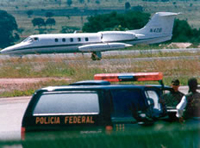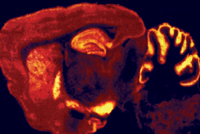A Trip Through Drugs: Costs & Consequences
As guests enter the Drugs: Costs & Consequences exhibit, they are faced with the ultimate cost of drugs: shattered dreams and lives. Through examples of people from real life, visitors learn their individual stories that are all too common. The issue of each person lines up with a section of the exhibit that the visitor will explore as they move through the gallery.
Included in this area is the vehicle wreckage from a fatal drug-related accident caused by impaired driving, with scattered photos, toys and drug chemicals–a startling and emotional reminder of the dangers of drug use.
From here, guests start their journey to learn about the science and impact of the drug trade on our bodies, our communities, and our world.
Production
Most of the growing and manufacturing of illegal drugs that are found on the streets of American cities do not often occur within our borders. Production often takes place in remote, mountainous areas around the world where opium, coca, and cannabis are grown and where clandestine labs for producing methamphetamine are found.
These are the principal drugs of the international illegal drug trade, and in this section of the exhibit, guests will learn how they were introduced to society historically and how they are made today: from the coca plants grown in Colombia to produce cocaine; to the poppy fields of Afghanistan that yield opium, heroin and morphine; to the cannabis fields in South America; to the methamphetamine factories in Mexico. Guests are able to view an authentic jungle coca lab, confiscated and displayed in the exhibit space, showing how cocaine is derived from coca leaves and made into cocaine; as well as a recreated Afghan opium/heroin processing laboratory in which sap from poppies is refined into heroin.

Hydroponics and “grow-lights” allow marijuana to be grown indoors.
Trafficking
Drugs are often smuggled into the United States to be distributed and sold. There are various ways of smuggling drugs. Some are as simple as hiding drugs in a secret compartment in a suitcase. Others are far more complicated, and involve hiding drugs in human beings acting as “mules,” people who risk their lives by swallowing condoms or balloons full of drugs. Several artifacts illustrate these smuggling methods, and maps highlight common drug trafficking routes throughout the world.

Mexican police prepare to raid a drug smuggling aircraft.
Money Laundering
Drugs are a big business, and a business that makes a lot of money. In the United States alone, Americans spend approximately $150 billion on illegal drugs. The money that is by made from drugs is often “laundered,” given to banks and businesses then redistributed to the traffickers in some way as “legal.” In the 1980s the Drug Enforcement Administration began focusing more on tracking the profits of drug dealing, and has made headway to block money laundering, though the process still continues. In 2020, the United Nations estimated the amount of money that is laundered internationally is between $800 billion and $2 trillion annually.
In this section visitors learn about some of the DEA’s money laundering investigations as well as some notorious figures in the drug money laundering trade. These include Gilberto Rodriguez Orejuela of the Cali Cartel in Colombia and Osama bin Laden, who with Al Qaida, has handled hundreds of millions of dollars from various organizations involved in the drug trade, including the Taliban. Guests also discover how money is able to be surreptitiously moved around the world through wire transfers, ATM cards, gold jewelry, and more.

Terrorists and drug dealers cannot operate without the help of money launderers.
Terrorism and 9-11
Here visitors learn the connection between manufacturing, illegal trade, money laundering, and terrorism through a powerful example. Pieces of the Twin Towers from Ground Zero in New York City and the Pentagon in Arlington, Virginia, September 11, 2001 are on display.
Drugs and the Body and Brain
In this section, the science of addiction is addressed: What is it? How does it affect the brain and other organs? How is it treated? How do brains recover from addiction damage? Guests learn how addiction controls the brain’s reward circuit, gradually altering motivation, pleasure, and desire. An interactive display illustrates this by demonstrating the effects of certain “rewards” in a normal brain versus an addicted brain. Guests can view imagery from actual MRI and PET scans that help scientists uncover the mysteries of addiction, loss of brain function due to drugs and recovery. An additional interactive display allows guests to hear true stories of addiction and recovery from addicts themselves. The science of how drugs affect other bodily organs and processes are addressed here.

Smoking marijuana can be addictive. THC attaches to receptors in the brain (bright yellow and orange) and impacts learning, memory and coordination.
The Cost to Children: The Terrible Toll
Drugs exact a terrible toll on children—the children of drug-using parents are often abused and neglected; young workers in the trade are forced to process and sell; youth are caught in the cross-fire of drug gangs; and more. Visitors see this toll first hand as they see photos that illustrate how children are impacted by drugs:
- Between 2014 and 2020 more than 3,500 children were found at operating methamphetamine laboratories around the United States. These children had been exposed to the toxic chemicals of meth production. Some were burned or killed by explosions; others were found in filthy and dangerous environments.
- Thousands of babies are born to drug users each year and many are “drug-affected,” meaning that their mother’s drug use causes them physical, mental or behavioral problems.
- Drug use itself is affecting younger and younger children. Studies indicate that some children are already abusing drugs at the age of 12 or 13.
- A display of a young teen’s bedroom shows just how easy it is to access Web sites that sell illegal drugs and indicators that your child may be involved in illegal drugs.
- Pharmaceutical drugs are also addressed.

Treatment often incorporates individual and group counseling to address shared and special needs. Treatment proceeds over a continuum, with stages of change, and critical importance on discharge planning and aftercare. (NIDA)
The Cost to Communities
Illegal drugs have had devastating impacts on communities across the country – urban to rural. Visitors explore a recreated methamphetamine lab built in an average motel room from any small to mid-sized community in America. Pictures and charts show the devastation of meth use and manufacture. Moving to urban communities, guests view the recreation of a section of an apartment, which illustrates the rise of crack. From the effects of the drug itself, to the violence caused by the buying and selling of the drug, crack has touched and continues to touch cities across the nation.
Other Costs of Drugs
There are many societal costs to the drug problem in this country – drug treatment, health care costs, law enforcement, and incarceration. Damage to the environment, dangerous driving, destroyed neighborhoods, and lost lives are all consequences of illegal drugs.
Damage to the environment is explored, especially in our national parks and with clear cutting of the rain forest in Central and South America for the planting of coca fields, the destruction of natural forests in the U.S. for the growing of marijuana, and the dumping of hazardous waste products into the water table after the manufacture of methamphetamine. (Just one pound of methamphetamine creates between five and six pounds of toxic waste.)
Local Story
Here visitors will learn about the local drug situation in their community and efforts of local law enforcement, prevention, and treatment organizations to curb the tide of illegal drugs. Through videos, graphics, and images, visitors can better understand the specific challenges and successes in their city and region and how the men and women of the DEA work tirelessly and strategically in their area.
Breaking the Cycle
Illegal drug abuse has been a concern in the United States for more than 150 years. The result has been a vicious cycle of drugs and drug-related violence that has consumed many American families. A combination of law enforcement, drug abuse education, and treatment programs have been and continue to be implemented across the country to combat substance abuse.
Discovery Corner
This area offers many resources from DEA and its partners on how the cycle of drug abuse and drug-related violence can be broken with awareness, outreach, and treatment. Computer kiosks offer access to different prevention and treatment websites, and literature is available from both national organizations and local resources. Venues can work with local providers, hold workshops, or decide how best to use the Discovery area.
An exhibit to increase community dialogue, encourage prevention, provide hope.
The exhibit provides the host venue and citizens in the community an opportunity to come together, work together, and create productive conversations and impactful action. Typically the venue works with local schools, drug prevention organizations, and treatment organizations, as well as other law enforcement groups.
DEA works locally and nationally to provide community information and to create synergy. It also works collaboratively with many national partners, chief among them the Drug Enforcement Administration Educational Foundation, which provides many recreational and informational options for young people around the country. Please continue to view the rest of the website for more information on hosting the exhibit and contact us at DEAMuseum@dea.gov.
